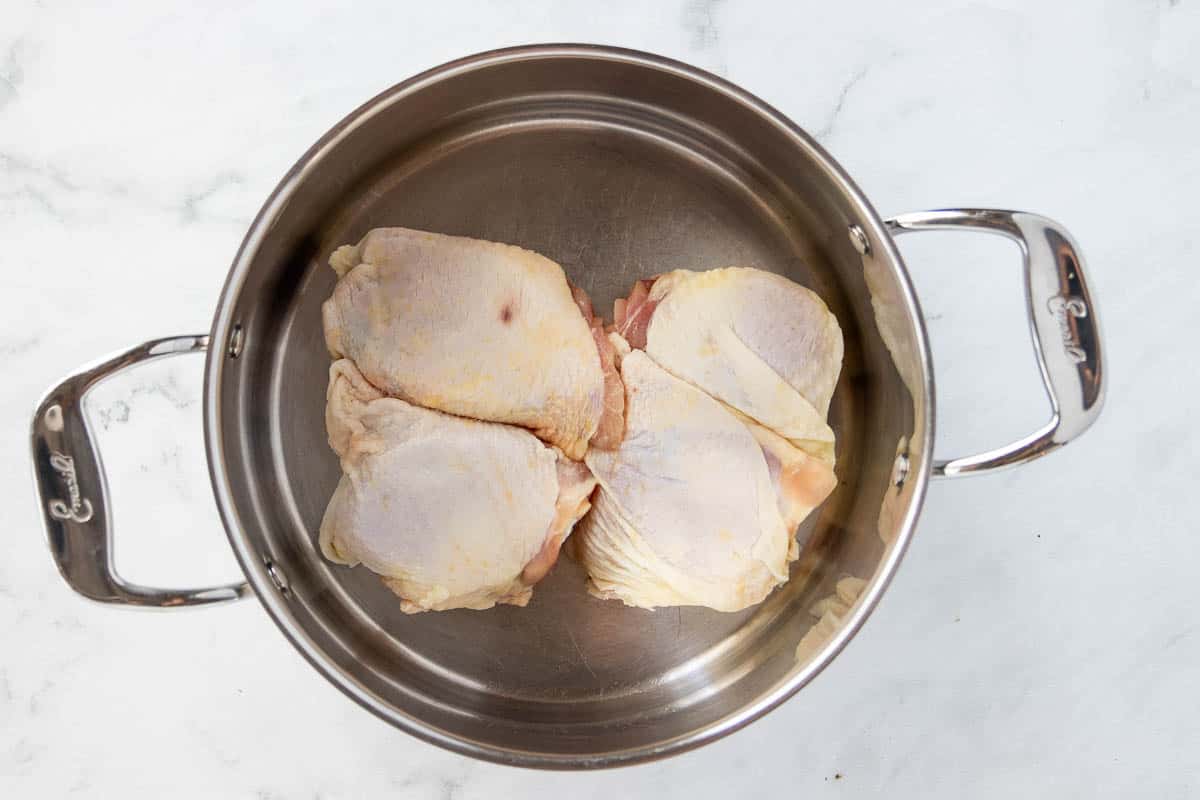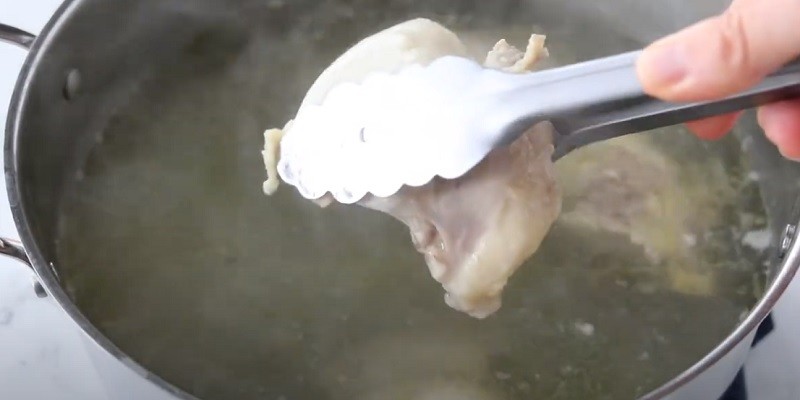To boil chicken thighs, place them in a pot, cover with water, bring to a boil, and simmer for 25-30 minutes until cooked through. Boiling chicken thighs is a simple and efficient way to prepare the meat for use in various recipes.
Whether you’re making chicken soup, salads, or casseroles, boiled chicken thighs provide a tender and flavorful base. This method also allows for the collection of a rich and tasty broth that can be utilized in other dishes. Moreover, boiling chicken thighs is a healthy cooking method, as it does not require additional fats or oils.
We will explore the process of boiling chicken thighs step by step, along with helpful tips for achieving optimal results.
The Basics Of Boiling Chicken Thighs
Boiling chicken thighs is a simple yet essential cooking method that can result in juicy, flavorful meat. Understanding the basics of boiling chicken thighs, from the benefits to preparing and essential ingredients, can elevate your culinary skills and ensure a delicious outcome every time.
Benefits Of Boiling Chicken Thighs
- Retains moisture and tenderness
- Easy to shred for soups, salads, and sandwiches
- Infuses the meat with flavorful broth
- Allows for easy seasoning and customization
Preparing The Chicken Thighs For Boiling
Before boiling the chicken thighs, it’s essential to follow these preparatory steps:
- Trim excess fat and skin for a leaner result
- Rinse the thighs under cold water and pat dry with paper towels
- Season with salt, pepper, and any desired herbs or spices
Essential Ingredients For Boiling
When boiling chicken thighs, you’ll need the following essential ingredients:
- Chicken thighs
- Water or chicken broth
- Seasonings such as salt, pepper, garlic, and herbs

Credit: www.createkidsclub.com
Step 1: Preparing The Chicken Thighs
When it comes to cooking chicken thighs, knowing how to prepare them properly is essential to achieve the best flavor and texture. The first step in boiling chicken thighs is to prepare them, which involves trimming excess fat and skin and then seasoning them to enhance their taste.
Trimming Excess Fat And Skin
Before boiling the chicken thighs, it’s important to carefully trim any excess fat and skin. This not only helps to improve the overall healthiness of the dish but also prevents the chicken from becoming too greasy. To do this, lay the chicken thighs on a clean cutting board and use a sharp knife to carefully remove any visible fat and excess skin. Make sure to trim any areas that seem particularly fatty, as doing so will result in a more flavorful and less oily finished product.
Seasoning The Chicken Thighs
After trimming excess fat and skin, the next step is to season the chicken thighs. Seasoning is crucial as it adds depth and complexity to the flavor of the meat. Begin by rubbing the chicken thighs with a generous amount of salt and pepper. Additionally, you can add garlic powder and paprika for an extra layer of flavor. It’s important to ensure that each thigh is evenly coated with the seasoning, so take your time to massage the spices into the meat thoroughly. This will result in a more flavorful and delicious end product once the chicken thighs are boiled.
Step 2: Boiling The Chicken Thighs
Boiling chicken thighs is a simple yet versatile cooking method that results in tender and juicy meat, making it a staple in many recipes. This step-by-step guide will help you master the art of boiling chicken thighs to perfection.
Choosing The Right Cooking Equipment
When boiling chicken thighs, it’s essential to use the right cooking equipment to ensure even cooking and optimal flavor retention. A large pot with a tight-fitting lid is ideal for this purpose. Ensure the pot is large enough to accommodate the chicken thighs without overcrowding, as this can affect the boiling process.
Adding Flavor Through Broth Or Seasoning
To enhance the flavor of the chicken thighs during the boiling process, consider adding flavorful ingredients such as broth, herbs, or aromatics to the cooking liquid. This will infuse the chicken with enticing flavors and aromas, elevating the overall taste of the dish. Alternatively, you can season the chicken thighs with your favorite spices before adding them to the boiling liquid, allowing the flavors to permeate the meat as it cooks.
Monitoring The Boiling Process
Once the chicken thighs are added to the boiling liquid, it’s crucial to monitor the boiling process closely to ensure that the meat cooks thoroughly without overcooking. Maintain a gentle boil throughout the cooking process, adjusting the heat as needed to prevent rapid boiling or simmering. Use a meat thermometer to check for doneness, ensuring that the internal temperature reaches at least 165°F (74°C) for safe consumption.
Step 3: Checking For Doneness
To check if the chicken thighs are cooked, use a meat thermometer to ensure the internal temperature reaches 165°F. The chicken should be firm to the touch and the juices should run clear, indicating that it is done.
Testing The Internal Temperature
When boiling chicken thighs, it’s crucial to ensure they are thoroughly cooked to a safe internal temperature. The USDA recommends that chicken should reach an internal temperature of 165°F (74°C) to be considered safe to eat. To check the internal temperature, use a meat thermometer inserted into the thickest part of the chicken thigh, avoiding the bone. Wait for a few seconds for an accurate reading.
Ensuring That The Chicken Is Thoroughly Cooked
Aside from using a meat thermometer, there are visual cues to verify that the chicken thighs are thoroughly cooked. The meat should appear white and opaque all the way through, with no pinkness or signs of rawness in the center. The juices that seep from the chicken should run clear, rather than being pink or red. Additionally, the chicken should feel firm to the touch, indicating it is fully cooked.
Serving And Storing Boiled Chicken Thighs
Boiled chicken thighs are a versatile and convenient protein option that can be prepared in various delicious ways. Knowing how to serve and store them properly ensures that you can enjoy their tender and flavorful goodness for several meals. Let’s explore the best practices for presenting, garnishing, and storing boiled chicken thighs to make the most of this versatile dish.
Presentation And Garnishing
When serving boiled chicken thighs, presentation and garnishing can elevate the overall dining experience. Consider slicing the boiled chicken thighs and arranging them on a plate with a vibrant assortment of fresh vegetables or herbs for a visually appealing presentation. Garnishing with a sprinkle of freshly chopped parsley or a drizzle of extra virgin olive oil can add a delightful burst of color and flavor to the dish, making it more appealing to the eye and palate.
Proper Storage Techniques
To maintain the quality and safety of boiled chicken thighs, it’s crucial to store them correctly. After boiling, allow the chicken thighs to cool to room temperature. Next, transfer them to an airtight container or wrap them tightly in plastic wrap before placing them in the refrigerator. Ensure the chicken is kept separate from other items to prevent cross-contamination. Properly stored boiled chicken thighs can be refrigerated for up to 3-4 days, ensuring they remain fresh and safe for consumption.
Tips For Repurposing Leftover Boiled Chicken
If you have leftover boiled chicken thighs, there are numerous creative ways to repurpose them in dishes such as salads, sandwiches, wraps, or stir-fries. Consider slicing the chicken thighs and adding them to a vibrant salad, or shredding the meat to use in a flavorful chicken salad sandwich. The tender and juicy texture of boiled chicken thighs makes them a versatile ingredient to use in various recipes, helping to minimize food waste while creating delicious meals.
Frequently Asked Questions For How To Boil Chicken Thighs?
What Is The Best Way To Boil Chicken Thighs?
The best way to boil chicken thighs is to place them in a pot, cover them with water, and bring to a simmer.
How Long Does It Take To Boil Chicken Thighs?
Boiling chicken thighs typically takes 25-30 minutes, or until they reach an internal temperature of 165°F (74°C).
Can You Add Spices While Boiling Chicken Thighs?
Yes, you can add spices such as salt, pepper, garlic, or herbs to the boiling water for added flavor.
What Should I Do With The Boiled Chicken Thighs?
After boiling, you can shred the chicken for tacos, salads, or soups, or use it in any recipe that calls for cooked chicken.
Is Boiled Chicken Thigh Healthy For A Diet?
Boiled chicken thighs can be part of a healthy diet, as the boiling method retains more nutrients compared to other cooking methods.
How To Ensure The Boiled Chicken Thighs Are Fully Cooked?
Use a meat thermometer to check that the internal temperature of the chicken thighs has reached 165°F (74°C) to ensure they are fully cooked.
Conclusion
Boiling chicken thighs is a simple and versatile cooking method. Whether you want to use the tender, flavorful meat in salads, soups, or as a standalone dish, this cooking technique can offer a variety of delicious options. With these easy steps, anyone can master the art of boiling chicken thighs.
Last Updated on April 23, 2025 by Pauline G. Carter

